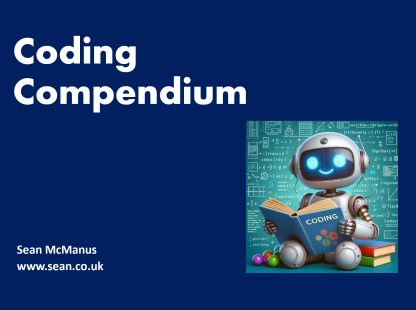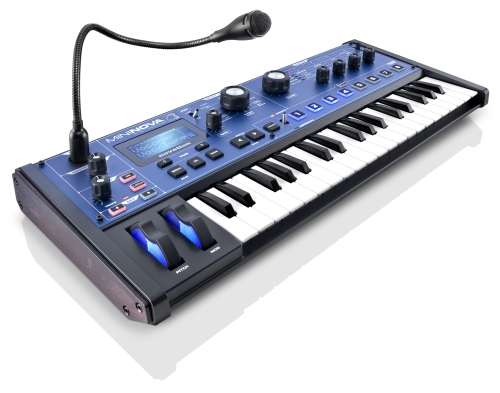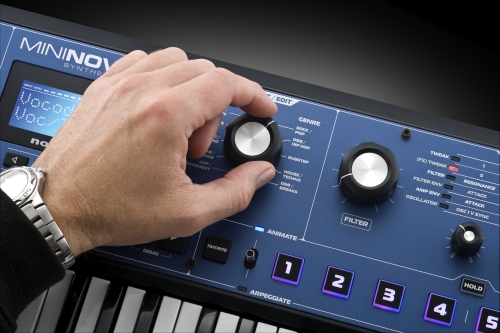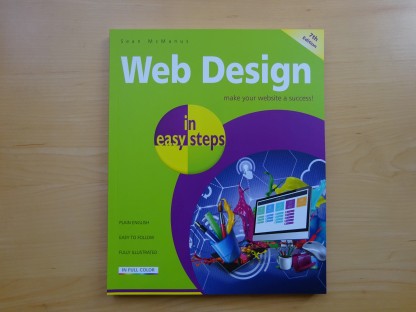
Coding Compendium
A free 100-page ebook collecting my projects and tutorials for Raspberry Pi, micro:bit, Scratch and Python. Simply join my newsletter to download it.
February 2014
Discover the Novation Mininova, a budget synthesizer that packs the sonic sophistication of a full size synth into a compact music keyboard. By Sean McManus.
Before I launch into the review, let me give you some context on why I got a Mininova. A few months ago, I connected my music home keyboard to my computer and started to use it with softsynths, emulators of often classic synthesizers. I was able to get some weird and wonderful sounds out of them, but the controls were far from intuitive. In particular, when I found a sound, I didn't know how to make it pulse more slowly, or to sound a bit softer. Those kind of things were a mystery to me, and the pretend dials on the screen were rather fiddly to operate with a mouse.
More and more, I had been reading about minisynths, the latest wave of hardware synths that shrink the synthesizer into a much smaller (and cheaper) box. You often get access to the same kinds of sounds that are available on full size synthesizers, but the pay-off is in the keyboard, which has fewer and smaller keys (typically three octaves, half size keys). I wondered whether having a real nobs and dials would be more intuitive and give more immediate feedback, than fiddling with pretend dials, so the idea started to form that I might get a synthesizer.
Between Christmas and New Year, I visited Denmark Street in London where there's a hub of instrument shops clustered, and tried out about four or five synths. I liked the Roland GAIA, which had good sounds and controls, but the default sounds seemed more appropriate for special effects than the kind of music I wanted to make. The MicroKorg XL+ had relatively few presets and I wasn't quite convinced by it. The Arturia Minibrute is all analogue, but is also monophonic and I knew I wanted to be able to slather my fingers over the keys and play melting chords.
I liked the Mininova from British company Novation, in particular the softer analogue-like sounds and the 80s style synth leads. I didn't buy it there and then, but I did return to the same shop that had given me the demo to buy it the next day. That surprised them, in an era where people often browse in a store and then buy online to save a few quid.
There are many things to love about the Novation Mininova. It has a good palette of default sounds, and you can download additional sounds from the Novation website to install into its empty third sound bank. These are the same sounds that work on the much more expensive Ultranova synth. There's a dial that enables you to choose between different types of sounds, so you can work through the bass or dubstep sounds, for example. I've seen that dial described as gimmicky in other reviews. I'm sure the marketing team had some input on which genres got a shout out. When there are 381 sounds (three banks of 127) to choose from, it can be a handy filter when you're looking for a particular sound, though.

Press photo of the Novation Mininova, showing the microphone for the vocoder on the left
It has a few features that appeal to the Jean-Michel Jarre fan in me. There is an arpeggiator, which you can use to play preprogrammed repeating patterns of notes. One of the downloadable voices (or patches) is named in tribute to Jarre and sounds a bit like some of Magnetic Fields or Concerts in China, and there's another one that faithfully replicates Pink Floyd's On the Run from the Dark Side of the Moon. It's a lot of fun to fiddle with the dials to add static type effects while the keyboard burbles away with the riff. Manic laughter is not supplied, but you can add your own. Using a row of buttons, you can turn on or off certain notes in the sequence, to add your own rhythm to the arpeggiator pattern.
There are some lead voices inspired by Gary Numan's Cars, and The Who's Won't Get Fooled Again, but if any of the patches sound too familiar or iconic to you, you can edit them. There are lots of other patches too that aren't so closely associated with music I know. Quite a few have a harsh dance-music sound, which is less appropriate for my kind of music, but there are some nice resonant bass sounds.
There's also a vocoder, that can create soft prog-rock voice effects, as well as more obvious "We are the robots!" Kraftwerk-style voices. I'm not sure how useful it is for my music, but it's a fun toy, and it comes as part of the package. I'm pleased it's there, and when I find the right song, I'm sure I'll use it.
There are several dials you can use to modify the sound. As well as a big filter dial, there are four nobs that can each adjust one of six parameters (including filter, filter envelope, amplitude envelope and oscillator). You use a slider at the side to switch which row of parameters you want to adjust with the dials. This works well, and is space efficient. The only drawback is that you can have a jolt in the effect when you first turn the dial. If a dial is set to 0 for the attack on the amplitude envelope, for example, and you move the slider so you can adjust the filter envelope, when you first turn the attack dial the attack will jump to 0, even if the programmed sound previously had an attack of, say, 50. These are good for programming sounds then, but might give unpredictable effects in performance.

Press photo showing the dial to choose voices (or patches) on the Novation Mininova. Beside it is the filter dial. The numbered buttons are for turning on or off parts of the arpeggiator pattern.
To add some variety to performance, there's a pitch bend wheel that is sprung to return to 0, and a mod wheel that isn't. The mod wheel can be quite sensitive, but really helps to add some depth to sounds, and make them feel more human and less static.
The Mininova comes with an external power supply. To connect it up, I got a cable from Maplin that takes the left and right output and feeds it into a stereo player's AUX socket. Running it through hi-fi speakers, I get a nice, rich sound off it. The sound quality is in any case much better than I was getting with the softsynths I was using. For recording, I feed the stereo output into the line in on my PC.
I've now connected the synth up to my existing home music keyboard using a MIDI cable, which means I have five octaves of full size keys available for playing the Mininova. So the only real shortcoming, the small keyboard, isn't really an issue. I was able to get a cheap MIDI cable on Amazon for a couple of pounds.
After a month of playing it, I'm happy to recommend the Mininova. I'll update my site and blog from time to time with news of my adventures in music with it. I'll be posting my music on Soundcloud, and you can hear my music here.
© Sean McManus. All rights reserved.
Visit www.sean.co.uk for free chapters from Sean's coding books (including Mission Python, Scratch Programming in Easy Steps and Coder Academy) and more!

A free 100-page ebook collecting my projects and tutorials for Raspberry Pi, micro:bit, Scratch and Python. Simply join my newsletter to download it.

Web Design in Easy Steps, now in its 7th Edition, shows you how to make effective websites that work on any device.

Power up your Microsoft Excel skills with this powerful pocket-sized book of tips that will save you time and help you learn more from your spreadsheets.

This book, now fully updated for Scratch 3, will take you from the basics of the Scratch language into the depths of its more advanced features. A great way to start programming.

Code a space adventure game in this Python programming book published by No Starch Press.

Discover how to make 3D games, create mazes, build a drum machine, make a game with cartoon animals and more!